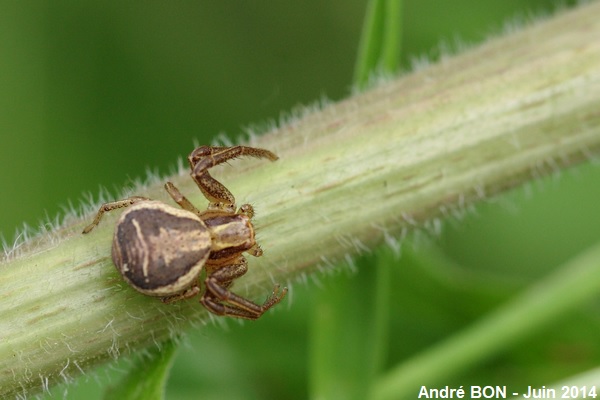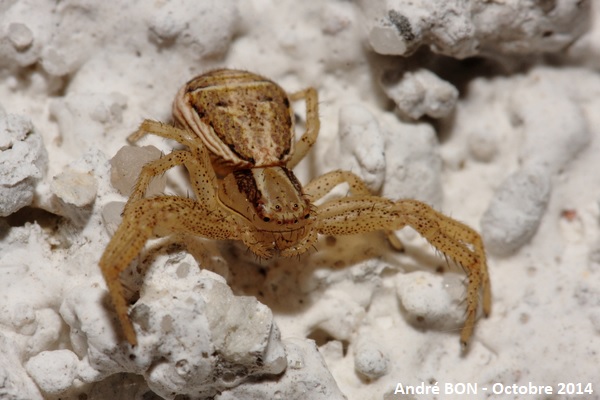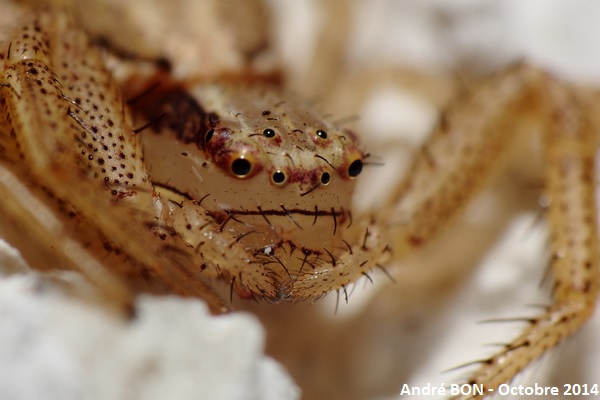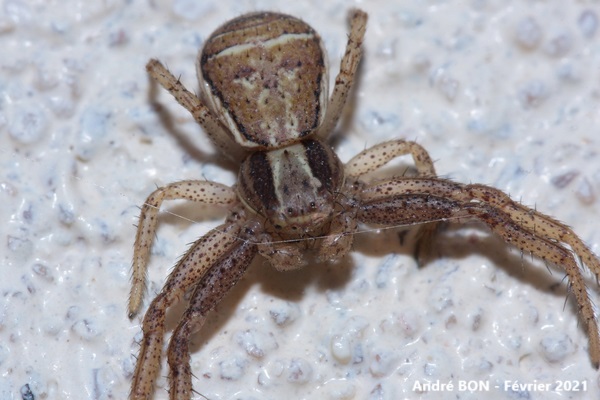




| Xysticus ulmi (Hahn, 1831) |





|
|
Scientific name: Xysticus ulmi (Hahn, 1831) Common name: French name: Order: Araneae Family: Thomisidae Size: Females: 5 to 8.3 mm; males: 3 to 4 mm. Biotope: Damp places, marshes, bogs, meadows, woodland edges. On low growing vegetation. Web: No web. The spiders of the Xysticus genus are used to hunting by sitting in wait on the low growing vegetation. Observation period: Mainly between April and September. Geographic area: Palearctic region, missing in Iceland. |
The spiders of the Xysticus genus are small-sized crab spiders characterized by two well developed fore leg pairs, a cephalothorax slightly smaller than the abdomen and often showing a pale median band. The edges of the cephalothorax show a dark line above a pale line. The abdomen is generally flattened. It is enlarged at the rear and often shows a dark leaf-shaped or pagoda-shaped median pattern. The four median eyes form a trapeze. It is square-shaped or wider than high on the spiders of the Xysticus genus, meaning that the median eyes are not laterally very close. The spiders of the Ozyptila genus, which are a smaller size and generally observed on the ground, are very similar to those of the Xysticus genus. However the median eyes are laterally closer to each other so that the trapeze shape is higher than wide. There are many similar species (about 360 worldwide, 71 in Europe) and it is very difficult to tell them apart without a microscopic exam of the genitalia. You can easily tell female Xysticus ulmi apart, they are a ground pale beige colour. The cephalothorax shows two very dark parallel lateral stripes. A paler cephalic triangle is located in between. Its rear point is very close to the abdomen. The abdomen is circled by a broad pale band and a dark border. The legs and sternum are powdered with tiny dark spots. Male Xysticus ulmi are a darker colour. They are difficult to identify among several similar species with pictures only. They show, like female, the two lateral parallel stipes on the cephalothorax. The cephalic triangle is outlined by a thin yellow line, also visible on the front side. The patella and femurs of the two front pairs of legs are black. The light-coloured cardiac patch on the abdomen is followed by one or two thin white cross lines. |
| [To know more about the Xysticus ulmi] [Next picture] [Top] |

|
Here is at least one member of the Xysticus genus for which we can tell the species. The main criteria for the species identification of this female Xysticus ulmi are visible on this picture. This spider was also very cooperative to walk on a graph paper sheet. I have been able to measure its exact body size, 3.5 mm from the tip of the abdomen to the front of the cephalothorax. I think that this one is a young female. |
| [To know more about the Xysticus ulmi] [Next picture] [Previous picture] [Top] |

|
I have observed this spider on the low growing vegetation bordering a small stream. |
| [To know more about the Xysticus ulmi] [Next picture] [Previous picture] [Top] |

|
The wall of the house is a perfect place for wildlife observation, first for the diversity found there and second for the ease to shoot pictures using the wall as a support for the camera. |
| [To know more about the Xysticus ulmi] [Next picture] [Previous picture] [Top] |

|
The use of reverse-mounted 24mm lenses is good way to get a very important magnification. This picture clearly shows the eye arrangement of the Thomisidae family. |
| [To know more about the Xysticus ulmi] [Previous picture] [Top] |

|
Little winter observation. |